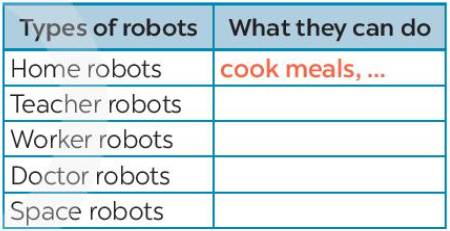Read the text again and fill the table below.

Hãy nhập câu hỏi của bạn vào đây, nếu là tài khoản VIP, bạn sẽ được ưu tiên trả lời.


Đáp án: D
Dịch: Nhiều người Việt Nam chuẩn bị cho Tết bằng cách nấu các món ăn ngày lễ đặc biệt và dọn dẹp nhà cửa.

Đáp án: A
On the+ số thứ tự
On the first day: vào ngày đầu tiên

Đáp án: B
Dịch: Có rất nhiều phong tục tập quán trong dịp Tết…

Read the text and complete the comparison table below.
BACTERIA AND VIRUSES
Both bacteria and viruses can cause diseases, but they are different in many ways. Bacteria are living organisms. They can live in many places, such as soil, water, and the human body. The smallest bacteria are about 0.4 micron* in diameter. Some bacteria in our bodies are helpful, but some can cause infectious diseases such as tuberculosis** or food poisoning. Antibiotics are often used to treat infections caused by bacteria.
*7 metre = 1 million microns
**a serious lung disease
Viruses are tiny germs that cause diseases in people, animals, and plants. They can cause a range of illnesses, from the common cold or the flu to more serious diseases such as AIDS and Covid-19. As they are very small (0.02 to 0.25 micron), viruses can get into our bodies easily. They are not living things, so they need to enter our bodies to become active. Then, they start to grow and cause the infected cell to make millions of copies of the virus. Vaccines are often used to prevent the spread of diseases caused by viruses.
| Bacteria | Viruses |
1. Living or not when entering the human body? | living | not living |
2. Which is smaller? | bigger
| smaller |
3. Examples of diseases they can cause | tuberculosis or food poisoning | common cold or the flu to more serious diseases such as AIDS and Covid-19 |
4. How to treat/prevent diseases caused by them? | antibiotics | vaccines |
| Bacteria | Viruses |
1. Living or not when entering the human body? | living | not living |
2. Which is smaller? | bigger | smaller |
3. Examples of diseases they can cause | tuberculosis or food poisoning | common cold or the flu to more serious diseases such as AIDS and Covid-19 |
4. How to treat/prevent diseases caused by them? | antibiotics | vaccines |

1 - 18 | 2 - technical education | 3 - higher education |
4 - university courses | 5 - bachelor’s degree |
1. 18
Thông tin: but in England they must stay in full-time education or do a training course until the age of 18.
(nhưng ở Anh, học sinh phải tiếp tục học toàn thời gian hoặc tham gia một khóa đào tạo cho đến năm 18 tuổi.)
2. technical education
Thông tin: That is why vocational education is often referred to as career education or technical education.
(Đó là lý do tại sao giáo dục nghề nghiệp thường được gọi là giáo dục nghề nghiệp hoặc giáo dục kỹ thuật.)
3. higher education
Thông tin: Many students still go on to higher education after receiving their vocational qualifications.
(Nhiều sinh viên vẫn tiếp tục học cao hơn sau khi nhận được bằng cấp nghề.)
4. university courses
Thông tin: Exams are taken at the end of the two-year course, and the grades are used to apply for university courses.
(Các kỳ thi được thực hiện vào cuối khóa học hai năm và điểm số được sử dụng để nộp đơn vào các khóa học đại học.)
5. bachelor’s degree
Thông tin: At university, students study for at least three years in order to get a bachelor’s degree.
(Tại trường đại học, sinh viên học ít nhất ba năm để lấy bằng cử nhân.)
Types of robots
(Loại robot)
What they can do
(Việc chúng có thể làm)
Home robots
(Robot gia đình)
cook meals, clean the house, do the washing, iron clothes
(nấu ăn, dọn dẹp nhà, giặt giũ, là / ủi quần ào)
Teacher robots
(Robot giáo viên)
help children to study, teach children English, literature, maths and other subjects, help children to improve their English pronunciation
(giúp trẻ học tập, dạy trẻ tiếng Anh, văn, toán và các môn học khác, giúp trẻ cải thiện khả năng phát âm tiếng Anh của mình)
Worker robots
(Robot công nhân)
build houses and move heavy things
(xây nhà và di chuyển vật nặng)
Doctor robots
(Robot bác sĩ)
look after sick people
(chăm sóc người bị bệnh / ốm)
Space robots
(Robot không gian)
build space stations on the Moon and on planets
(xây trạm không gian trên mặt trăng và trên các hành tinh khác)